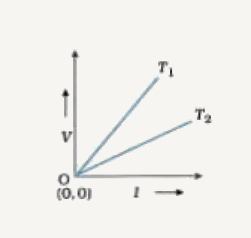The graph for a conductor makes angle with V-axis. Here denotes voltage and denotes current. The resistance of the conductor is given by :Solution in Kannada
.
Step by step video & image solution for The V -1 graph for a conductor makes angle theta with V-axis. Here V denotes voltage and T denotes current. The resistance of the conductor is given by : by Physics experts to help you in doubts & scoring excellent marks in Class 12 exams.
Updated on:21/07/2023Similar Questions
The voltage-current (V-I) graph of a metallic conductor at two different temperatures T1 and T2 is shown below. At which temperature is the resistance higher ?

View SolutionThe V-I graph for a good conductor makes angle 42∘ with V-axis. Here V denotes voltage and I denotes current. Then the resistance of the conductor will be
View SolutionAssertion: For good conductors, the I-V graph is a perfect straight line inclined to current axis. Reason: By Ohm's law, voltage across the ends of a conductor is directly proportional to the resistance of the conductor.
View SolutionThe voltage - current (V-1) graphs for a metallic conductor at two different temperatures T1andT2 are shown below:

At which temperature is the resistance higher?
View SolutionChoose correct alternative.
I.V. graph for conductor makes an angle θ with Y-axis. Then the resistence of conductor is given by
View SolutionSelect and write the most appropriate answer from the given alternatives The I.V. graph of a conductor makes an angle theta with x - axis. Here, V denotes voltage and I denotes current. The resistance of conductor is given by
View SolutionThe graph showing the varation of potential difference V along x-axis and current I along y-axis for a conductor makes an angle 40∘ with the x-axis. The resistance of the conductor will be
View Solution